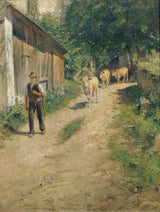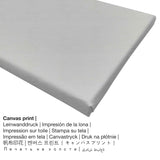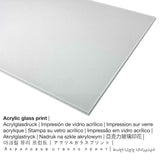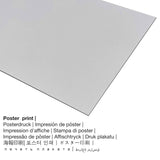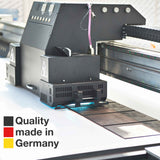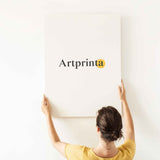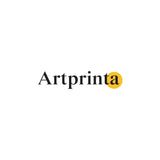Emil Strecker, 1899 - Onye njide na-abịa - mbipụta nka mara mma
Ụtụ gụnyere. Mbupu gbakọrọ na ndenye ọpụpụ.
Ozi ndabere ngwaahịa nka
a 19th narị afọ ihe esere ihe nka nwoke artist Emil Strecker. E ji nha ya see nke mbụ ya: 76 x 58 cm - akụkụ etiti: 104 x 86 x 9,5 cm. Mmanụ na kwaaji was used by the German painter as the technique for the artwork. The original artwork is inscribed with the details: "signed and label lower left: E. Strecker / Durnstein: Danube.". The artwork can be viewed in in the digital collection of Belvedere in Vienna, Austria. Site n'ikike nke © Belvedere, Vienna, nọmba ngwa ahịa: 3601 (ikikere: ngalaba ọha). Besides, the artwork has the following creditline: transfer from the Kunsthistorisches Museum, Vienna. - 1939 inventory in 1921. Furthermore, alignment of the digital reproduction is portrait and has a side ratio of 3 : 4, which means that ogologo bụ 25% mkpụmkpụ karịa obosara. The painter Emil Strecker was a European artist, whose art style can be classified as Realism. The Realist painter lived for 84 years, born in the year 1841 in Dresden, Saxony, Germany and died in 1925 in Durnstein, Niederosterreich, Austria.
Nkọwa gbasara nka nka pụrụ iche
| Aha ọrụ nka: | "The holder comes" |
| Nhazi nka: | sere |
| Category: | nkà nke oge a |
| oge: | 19th narị afọ |
| Afọ nka: | 1899 |
| Ogologo afọ nka nka: | 120 afọ |
| Agba na: | mmanụ na kwaaji |
| Nha izizi: | 76 x 58 cm - akụkụ etiti: 104 x 86 x 9,5 cm |
| Ederede nka nka izizi: | signed and label lower left: E. Strecker / Durnstein: Danube. |
| Ụlọ ihe ngosi nka: | Belvedere |
| Ebe ebe ngosi nka: | Vienna, Austria |
| website: | Belvedere |
| Ụdị ikike nka: | ngalaba ọha |
| Site n'aka: | © Belvedere, Vienna, nọmba ngwa ahịa: 3601 |
| Ebe E Si Nweta: | nyefee site na Kunsthistorisches Museum, Vienna. - 1939 ngwaahịa na 1921 |
Ozi omenka
| Aha onye nka: | Emil Strecker |
| Aha utu aha: | Emil Strecker, Strecker, e. strecker, Strecker Emil |
| okike onye nka: | nwoke |
| Obodo onye nka: | German |
| Ọrụ nke onye na-ese ihe: | onye na-ese ihe |
| Obodo obibi: | Germany |
| nhazi ọkwa: | omenkà nke oge a |
| Ụdị nka: | Ihe ngosi |
| Oge ndu: | 84 afọ |
| Afọ amụrụ: | 1841 |
| Ebe amụrụ onye: | Dresden, Saxony, Germany |
| Afọ ọnwụ: | 1925 |
| Obodo ọnwụ: | Durnstein, Niederosterreich, Austria |
Họrọ ụdị ihe dị iche iche
Anyị na-enye ụdị dị iche iche nha na ihe maka ngwaahịa ọ bụla. Nhọrọ ndị a dị maka n'otu n'otu:
- Mbipụta enyo acrylic: An print on acrylic glass, which is sometimes named as a print on plexiglass, makes the original into marvellous décor. Moreover, it offers a great alternative to aluminium and canvas fine art replicas. Your favorite artwork is being made with modern UV direct print machines. This creates the effect of impressive, vivid colors.
- Aluminom dibond mbipụta (ọla): Aluminium Dibond prints are metal prints with an outstanding effect of depth. The Direct Print on Aluminum Dibond is the perfect start to fine art reproductions on aluminum. The colors are luminous and vivid in the highest definition, details appear crisp, and you can really perceive a matte appearance of the fine art print.
- Akwụkwọ mmado ebipụtara (akwa akwa akwa): The Artprinta poster is a printed canvas paper with a slight surface finish. It is suited for framing the fine art print using a custom frame. Please note, that depending on the size of the poster print we add a white margin of approximately 2-6cm around the work of art, which facilitates the framing.
- Mbipụta kanvas: The UV printed canvas material mounted on a wooden stretcher frame. A canvas has a particular impression of three-dimensionality. Also, a printed canvas creates a cosy and comfy appearance. A canvas of your favorite work of art will let you turn your new into a large size collection piece like you would see in a gallery. A canvas print has the great advantage of being low in weight, meaning that it is easy to hang your Canvas print without any wall-mounts. That is why, a canvas print is suited for any kind of wall.
Banyere ihe a
| Bipụta ụdị ngwaahịa: | ọrụ mgbidi |
| Usoro mmeghari: | dijitalụ mmeputakwa |
| Usoro mmepụta: | mbipụta dijitalụ (Mbipụta UV ozugbo) |
| Production: | Germany |
| Ụdị ngwaahịa: | mmepụta ihe na-achọ |
| Eji ngwaahịa a chọrọ: | mgbidi gallery, nchịkọta nka (mmepụta) |
| Ndozi onyonyo a: | usoro eserese |
| Oke akụkụ onyonyo: | ( Ogologo: obosara) 3: 4 |
| Ihe: | ogologo bụ 25% mkpụmkpụ karịa obosara |
| Nhọrọ akụrụngwa: | akwụkwọ mmado (akwụkwọ kwaaji), mbipụta enyo acrylic (nke nwere ezigbo mkpuchi iko), mbipụta ọla (aluminium dibond), mbipụta kwaaji |
| Mbipụta kanvas (akwa akwa na etiti ihe ndọtị) dị iche iche: | 30x40cm - 12x16", 60x80cm - 24x31", 90x120cm - 35x47", 120x160cm - 47x63" |
| Mpempe iko acrylic (nwere ezigbo mkpuchi iko) nha: | 30x40cm - 12x16", 60x80cm - 24x31", 90x120cm - 35x47", 120x160cm - 47x63" |
| Mbipụta akwụkwọ mmado (akwụkwọ kwaaji): | 30x40cm - 12x16", 60x80cm - 24x31", 90x120cm - 35x47" |
| Nhọrọ mbipụta aluminom: | 30x40cm - 12x16", 60x80cm - 24x31", 90x120cm - 35x47" |
| Nhazi mmeputa nka nka: | agunyeghi |
Ederede iwu dị mkpa: We try the best we can in order to describe the products as closely as possible and to demonstrate them visually. At the same time, the tone of the printed materials and the imprint can diverge to a certain extent from the image on the monitor. Depending on the settings of your screen and the condition of the surface, not all colors are printed 100% realistically. Since the fine art prints are printed and processed manually, there may also be minor discrepancies in the motif's exact position and the size.
Ederede a bụ ikike ọgụgụ isi ma chekwaa ya site na nwebisiinka © | Artprinta.com

